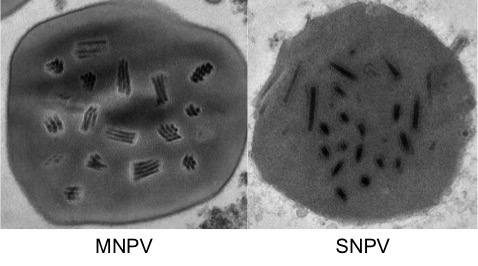Viral control of the Douglas-fir tussock moth
Using epidemiological theory to inform practice
Outbreaks of the Douglas-fir tussock moth (DFTM) can cause massive die-offs in Douglas-fir stands, as well as other True fir species across western North America. To combat the ecological and economic losses due to these large defoliation events, the US Forest Service has developed a natural baculovirus as an EPA-approved insecticide, specific to DFTM. The use of viral agents against forest defoliators, however, does not typically take into account critical aspects of host-pathogen biology, particularly the density-dependent nature of transmission and non-linearities. We are seeking to better understand the application of this viral pesticide by combining experiments that measure transmission and mechanistic models that explain long-term dynamics.


Maintenance of viral polymorphism
A noteworthy aspect of the Douglas-fir tussock moth (DFTM) – virus biology is that two morphotypes of the baculovirus (OpNPV) exist in nature, which differ both genetically and based on ultrastructure. One type, the multi-capsid type (OpMNPV) bundles multiple virus particles into membranes within the polyhedral inclusion body, while the single-capsid type (OpSNPV) packages virus particles without bundling.

Past experiments, as well as my own pilot studies, show that these two types differ in key epidemiological characteristics, including their average transmission rates and the heterogeneity of transmission among hosts. These differences can affect epidemic patterns and, therefore, should affect the choice of virus for control of DFTM. Interestingly, there is also a latitudinal cline in the distribution of these virus types, where OpMNPV seems to occupy more northern latitudes (British Columbia to northern Oregon), while OpSNPV occupies more southern latitudes (Oregon to Arizona and New Mexico), with areas of coexistence in the central range.
My collaborators and I plan to study the causes and consequences of this pattern of coexistence. Particularly, we will address the hypothesis that coexistence is promoted by host tree species heterogeneity. DFTM primarily feed upon Douglas fir, but also utilize True fir species (Abies spp.). It is possible, then, that the virus types have different fitness on different host tree species. Alternatively, latitude could affect coexistence via correlated changes in the abiotic environment. We plan to combine careful field transmission experiments with mechanistic models and deep sequencing in order to evaluate the mechanisms that most impact viral coexistence in this system.
